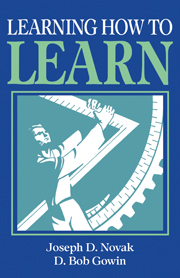Book contents
- Frontmatter
- Contents
- Foreword
- Preface
- Acknowledgments
- 1 Learning about learning
- 2 Concept mapping for meaningful learning
- 3 The Vee heuristic for understanding knowledge and knowledge production
- 4 New strategies for instructional planning
- 5 New strategies for evaluation: concept mapping
- 6 The use of the Vee for evaluation
- 7 The interview as an evaluation tool
- 8 Improving educational research
- Appendixes
- References
- Index
2 - Concept mapping for meaningful learning
Published online by Cambridge University Press: 05 June 2012
- Frontmatter
- Contents
- Foreword
- Preface
- Acknowledgments
- 1 Learning about learning
- 2 Concept mapping for meaningful learning
- 3 The Vee heuristic for understanding knowledge and knowledge production
- 4 New strategies for instructional planning
- 5 New strategies for evaluation: concept mapping
- 6 The use of the Vee for evaluation
- 7 The interview as an evaluation tool
- 8 Improving educational research
- Appendixes
- References
- Index
Summary
THE NATURE AND USES OF CONCEPT MAPS
Concept maps are intended to represent meaningful relationships between concepts in the form of propositions. Propositions are two or more concept labels linked by words in a semantic unit. In its simplest form, a concept map would be just two concepts connected by a linking word to form a proposition. For example, “sky is blue” would represent a simple concept map forming a valid proposition about the concepts “sky” and “blue.”
Except for a relatively small number of concepts acquired very early by children through a discovery learning process, most concept meanings are learned through the composite of propositions in which the concept to be acquired is embedded. Although concrete empirical props may facilitate concept learning, the regularity represented by the concept label is given additional meaning through propositional statements that include the concept. Thus, “grass is green,” “grass is a plant,” “grass grows,” “grass is a monocot,” and so on lead to increasing meaning and precision of meaning for the concept “grass.” A concept map is a schematic device for representing a set of concept meanings embedded in a framework of propositions.
Concept maps work to make clear to both students and teachers the small number of key ideas they must focus on for any specific learning task. A map can also provide a kind of visual road map showing some of the pathways we may take to connect meanings of concepts in propositions.
- Type
- Chapter
- Information
- Learning How to Learn , pp. 15 - 54Publisher: Cambridge University PressPrint publication year: 1984
- 16
- Cited by



